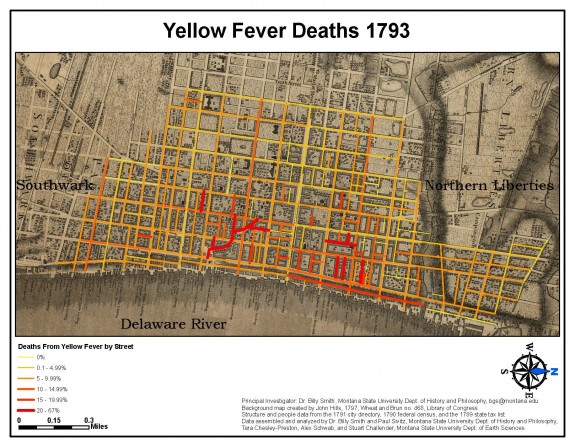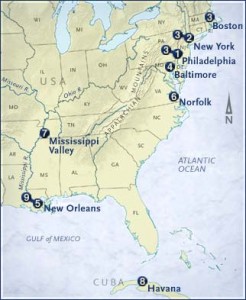The Spread of Yellow Fever from Haiti to the U.S.
Yellow Fever has had a long history on the island of Haiti. British troops felt its devastating effects as early as 1793. Later in 1802 French troops were sent by napoleon to put down a slave revolution. More than 70% of the initial 30,000 scummed to yellow fever. With Yellow Fever killing most of the French Troops the Anti-Colonial force lead by Toussaint Louverture was able to take back control of Haiti. French Slave owners fled the island for locations such as New Orleans and Philadelphia. Yellow fever traveled with these men to the United States and had a profound effect on cities such as Philadelphia.
So why do we talk about the Yellow Fever epidemic in Philadelphia and not New Orleans? In 1763 the Spanish government of New Orleans banned the immigration of enslaved Haitians to the city. This ban was in response to the Haitian revolution. Southern slave holders did not want their slaves influenced by Haitian revolutionaries. This ban forced Haitian farmers and their slaves to find another place to go. They landed in port cities along the east coast where the ban did not exist, such as Charleston SC, Norfolk VA, and Philadelphia PA. Haitian planters and their slaves brought yellow fever with them to these port cities. Yellow Fever hit these ports hard because people in America had no immunities to this tropical disease. The following timeline tracks down the spread of Yellow Fever from Haiti to the United States:
http://timeglider.com/t/84232ee2a7b74919?min_zoom=1&max_zoom=100
Yellow Fever in Philadelphia
Yellow fever had originally struck Philadelphia around 1747, but the city managed to contain the disease quickly. However, in 1793, yellow fever made its way to Philadelphia once again and this time ravaged the entire city, killing 5,000 people out of a total population of 45,000 between August 1st and November 9th of 1793. In addition to this number, it is estimated that 17,000 people fled from the city (Source: http://www.history.com/this-day-in-history/yellow-fever-breaks-out-in-philadelphia and http://www.eyewitnesstohistory.com/yellowfever.htm).
Benjamin Rush, a local physician, managed to keep a recording of the various patients he treated for yellow fever as well as his thoughts regarding the causes and treatments for the disease. Rush’s notes on the epidemic in Philadelphia indicate that physicians of that time period had discovered that yellow fever was found in two stages and differed in symptoms and degree in patients. However, treatments included purging and bleeding; a sign that the scientific community still believed that the yellow fever was related to the four humors (Source: http://deila.dickinson.edu/theirownwords/title/0020.htm-“About the book”).
The link to the interactive timeline below focuses on these months and depicts some of the cases noted by Rush as well as key dates regarding the spread of Yellow Fever in Philadelphia in 1793:
http://timeglider.com/t/2ead2a3533b7f924?min_zoom=1&max_zoom=100

Coastal port cities were most vulnerable to early outbreaks of Yellow Fever. Not only were these areas high traffic ports, but also they were rapidly growing areas with tightly packed populations. Many of the traffic in the ports were from traveling merchants and also refugees from Haiti, contaminated with Yellow Fever when they arrived in port. The first cases of Yellow Fever in the United States started to appear in the 1790s, in the cities of New York, Charleston, Philadelphia, and New Orleans.Throughout the next century, thousands of Americans died and even more became sick with the fever. In many places of the United States, as much as ten percent of the population died every year from epidemics of Yellow Fever.
The southern region of the United States was most affected by Yellow Fever up until the early 20th century. The temperate climate made optimal breeding grounds for the mosquitoes carrying Yellow Fever. The areas of the south were also less organized than Northern cities because of a rapidly growing population of those areas. The port town of New Orleans suffered considerably during the late 18th and early 19th centuries. In 1796 and 1799, major epidemics killed 600 people combined which was between five and ten percent of the population at the time. The invention of the steamboat and extensive railroad networks carried the disease throughout the United States into the interior, especially in the South.
Northern cities suffered their last epidemic in 1822 with the large epidemic in New York City. At this point, quarantines and isolation measures for infected sailors and passengers exhibiting symptoms at port were put into place and seemed to be working well to control the Yellow Fever north of Virginia. Southern cities were slower to adopt quarantine measures and could not keep up with their explosive growth in population in order to control their public heath. This caused the large number of deaths and epidemics in the South with only a brief period of relief during the Civil War. Northern blockades and restriction of trade of Southern ports may have been detrimental to the South’s economy during the war, but was a major reason Yellow Fever epidemics were almost non-existent during this time period.

Want to learn more about the spread of Yellow Fever? Check out these great sources that were used in our research:
- pbs.org/wgbh/amex/fever/map/
- http://wwww.ncbi.nlm.nih.gov/pmc/articles/PMC1750233/?page=2
- http://pabook.libraries.psu.edu/palitmap/YellowFeverHaulingDead.jpg
- http://www.tip.sas.upenn.edu/curriculum/units/2009/02/09.02.09.pdf
- “African American Migration Experience.” AAME :. Accessed April 22, 2015. http://www.inmotionaame.org/migrations/landing.cfm?migration=5&bhcp=1.
- Marr, John S., and John T. Cathey. “The 1802 Saint-Domingue Yellow Fever Epidemic and the Louisiana Purchase.” Journal of Public Health Management and Practice: 77-82.
- http://philadelphiaencyclopedia.org/archive/yellow-fever/yellow-fever-1793-jpg/
- http://faculty.humanities.uci.edu/bjbecker/PlaguesandPeople/week7c.html
- http://deila.dickinson.edu/theirownwords/title/0020.htm
- http://www.eyewitnesstohistory.com/yellowfever.htm
Pictures for the Philadelphia Yellow Fever Timeline found in the following sources:
- http://pabook.libraries.psu.edu/palitmap/YellowFeverHaulingDead.jpg
- http://www.tip.sas.upenn.edu/curriculum/units/2009/02/09.02.09.pdf
- https://en.wikipedia.org/wiki/Andrew_Hamilton_(lawyer)#/media/File:Andrew_Hamilton_Bush_Hill_Drawing.png
- http://29deadpeople.com/wp/?page_id=444
- http://www.historyforkids.org/learn/science/medicine/yellowfever.htm
- https://www.globalcitizen.org/en/content/these-9-historical-quarantines-can-teach-us-a-lot/
This blogpage was created by Adrika Venkatanarayanan, Cody White and Allison Terry